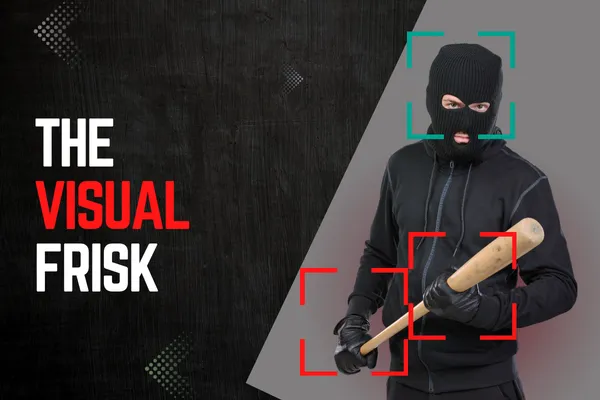
The Visual Frisk
The Visual Frisk: Street-Smart Threat Recognition for Everyday Life
One Simple Skill to Keep You Alive and Able to Respond in Seconds (or Less)

You’re walking to your car with your hands full. Someone suddenly appears nearby and triggers your “gift of fear” just as you become vulnerable.
Is it a mugger—or a fellow shopper—or someone looking to sell cookies?
In that moment, you don’t rise to the occasion—you fall to your level of awareness.
This visual frisk is a go-to tool that has not only saved my life—but has also allowed me not to take a life when a shooting could have been catastrophic.
Two incidents come to mind as I write this. In the first, I was conducting an urban operation in Mosul, Iraq, with my team and a group of Iraqi commandos. It was night, we had an explosive breach, and hit the compound with violence of action. For some reason, one commando had gotten ahead of the main clearing force, and on his own, he checked out an area behind a curtain. He had visually lost his link to the team. As I came into the room, the only thing I saw was the muzzle of a weapon coming towards me from behind the curtain. I brought my weapon up and at just the last fraction of a second saw the telltale front sight post of an M-4/M-16. It was definitely not an AK-47 that I would have expected. I paused just a moment because of what was in his hands, and then saw that the whole person was in uniform, with a helmet, and was a friendly soldier coming out, not in the process of attack. Shooting would have been catastrophic.
While I was working as a police officer, a suspect I was arresting looked towards his pocket and reached for a pocket knife with the clip exposed outside his front pocket. I had just noticed the knife as his shirt moved out of the way. I told him not to move, but he thought otherwise and began to reach for it. I was already close and luckily was able to foul his draw and strike him immediately, knocking him to the ground. The oddest part is he went from possibly trying to kill me to complaining about the bloody lip he received. You just can't keep criminals happy.
In both cases, I had precious little time to decide and act. With a little mental rehearsal and practice, this skill becomes second nature.
That’s where the Visual Frisk comes in. Also known as the Immediate Threat Assessment, this is a non-contact way to rapidly assess a person for potential danger. Think of it as a quick, trained scan—used by pros but applicable to anyone with the right mindset and guidance.
Everyone knows about a police pat-down or frisk, where an officer stops a subject believed to be armed and dangerous and literally “pats down” exterior clothing to check for weapons. This is essentially the same thing but done hands-off, from a distance, and often without the subject even knowing it. You can do it relatively quickly and intuitively or take more time and dial in on the details.
This method, promoted by Paul Howe, a respected former Delta Force Operator and well-known trainer, mirrors the principles used by seasoned professionals to evaluate threats without touching a suspect. The goal is to visually process a person from head to toe, looking for behavioral and physical cues that signal danger. I take this simple checklist to the next level in a lot of my courses.
Whether you’re approached by a homeless-looking individual asking for money, a stranger who “just happened” to walk up behind your car, or someone whose presence simply feels off—this is your opportunity to make a decision before you’re in a fight.
In this video, I am teaching a group of recruits in a local academy. The exact same principles apply to everyday citizens.
Watch the video: https://youtube.com/shorts/fz86IccZMMk?feature=share
The Visual Frisk provides a simple framework for enhancing safety. With a little practice, you can perform in under two seconds. Note that there is a general order, but one thing may attract your attention first, and you may have to work the list from there.
Here’s what to look for:
1. Whole Person – What’s your first impression? Calm, distracted, or focused on you in a predatory way? Is that your spouse or kid in the kitchen getting a snack late at night—or an armed burglar?
2. Hands – Are they visible? Are they clenched? Are they moving in sync—or in a way that hides something? What’s in them?
3. Waistband – It’s the most common place to stash a weapon. Do a quick scan—front and back. Look for obvious bulges, printing under clothing, jacket sag, or asymmetry.
4. Surroundings – Is there anything within reach they could use as a weapon? Are they blocking your escape route? Criminals will often set a weapon down to take goods, or they may hide them nearby or keep them in bags or backpacks.
5. Demeanor – Pay attention to how they act before they see you, as they notice you, and during any interaction. Sudden shifts in behavior when you or any aware person is noticed, matter. The way they respond to any dialogue is a huge tell.
The Visual Frisk is a foundational part of our Street-Savvy Awareness System, built for everyday people who want the street sense of a seasoned cop or special operator—Be prepared. Be confident. Be street-savvy.
Trevor
Grey Group LLC | Threat-Proof Network | Practical Safety Training for Everyday Life having to live like one.
📘 Want to train your mind to read people like a pro?
Check out the Street-Savvy Pro Guide—our complete system for mastering awareness and spotting threats before they happen.
🎯 Use code SAVVY30 for 30% off
